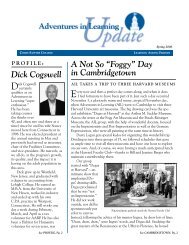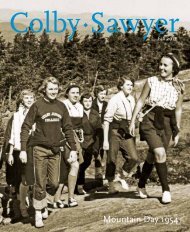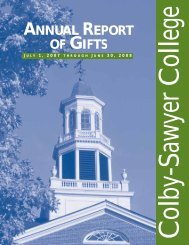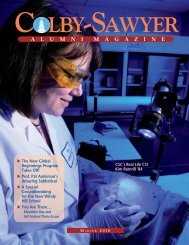A L U M N I M A G A Z I N E - Colby-Sawyer College
A L U M N I M A G A Z I N E - Colby-Sawyer College
A L U M N I M A G A Z I N E - Colby-Sawyer College
You also want an ePaper? Increase the reach of your titles
YUMPU automatically turns print PDFs into web optimized ePapers that Google loves.
esponses to a new problem, and the<br />
generation of a response required a reformulation<br />
of the problem. I reflected on<br />
the fiscal challenges I faced as a graduate<br />
student, a time when eating nothing<br />
but ramen noodles and sleeping in my<br />
car was an acceptable way to stretch my<br />
resources. While incomprehensible now,<br />
the younger man I once was accepted<br />
this as a perfectly reasonable solution. As<br />
I reminisced on the incredible power of<br />
students to achieve great things with few<br />
resources, the challenge we had originally<br />
set out to address shifted subtly to allow for a solution.<br />
The advisory group initially approached the challenge of<br />
a larger than expected incoming class as one of “top-down”<br />
resource allocation, but we came to see that reframing the problem<br />
and our role in it would lead to more effective solutions.<br />
The memory of my years as a cash-strapped but intellectually<br />
curious student allowed me to realize that the honors program<br />
could tap into the energy, adaptability and frugality of the honors<br />
students themselves. While Wesson Weekends provided an<br />
excellent opportunity for faculty to create and lead academic<br />
excursions, this faculty-driven program could be expanded to<br />
include a “bottom-up” program designed to fund projects created<br />
and led by students themselves. This was the seed that,<br />
with the enthusiastic guidance of Wesson Honors Program<br />
Coordinator Ann Page Stecker and support of the advisory<br />
group, grew into the Wesson Idea Fund.<br />
The Wesson Idea Fund provides resources for students to<br />
initiate and undertake independent learning projects that complement<br />
and enrich their <strong>Colby</strong>-<strong>Sawyer</strong> experience. Students,<br />
either individually or in pairs, apply for funding by writing<br />
a grant proposal that outlines the goals, timeline and budget<br />
for a project of their own creation. Students must also lay out<br />
a plan for how the applicant(s) will share the project with the<br />
When we learned about the Wesson<br />
Idea Fund, we were excited. We thought<br />
the best way to gain a more objective<br />
understanding of the Tibetan situation<br />
would be to talk to as many people with<br />
as many perspectives on the issue as possible.<br />
There is a significant Tibetan refugee<br />
population in Nepal and India, and we<br />
knew that the opportunity to talk to both<br />
the refugee and the host populations in<br />
these countries would be invaluable to our<br />
research. As a college student strapped for<br />
cash, I had been planning to spend almost<br />
all my savings on my plane ticket to China.<br />
The grant we received from the Wesson<br />
Idea Fund made extended travel into India<br />
Ye “Julia” Zhu ’13 (back row, center) and two other student teachers pose with their students at Hefei<br />
Guang Cai Hope Primary School in Fei Dong, Anhui Province, China. Julia was able to study primary<br />
education in China in summer 2010 and introduced new activities in the classrooms through support from<br />
a Wesson Idea Fund grant.<br />
and Nepal possible.<br />
The Wesson Idea Fund emphasizes<br />
how an independent project can have an<br />
impact on the community at large. When I<br />
returned from Asia, everyone was eager to<br />
hear about my travels. It was in answering<br />
questions and sharing stories that I truly<br />
realized the significance of the project.<br />
We didn’t come to any great conclusions<br />
about Tibet, but we did bring the issues<br />
of sovereignty and the refugee situation<br />
to the attention of many people in the<br />
<strong>Colby</strong>-<strong>Sawyer</strong> community. We initiated an<br />
important conversation.<br />
Before the project, I had the vague<br />
notion, probably planted by Lisa Simpson<br />
<strong>Colby</strong>-<strong>Sawyer</strong> community. Toward the goal of increasing faculty/student<br />
interaction and shared learning, project proposals<br />
must also be endorsed by a faculty mentor, and are reviewed by<br />
a committee of faculty and staff who collectively decide which<br />
projects to fund.<br />
Though only in its second year, the positive effect of the<br />
Wesson Idea Fund is already being felt. The academic impact<br />
of the program has most immediately, and clearly, been seen<br />
at the level of individual student learning. The Idea Fund offers<br />
rare opportunities to undergraduate students: financial support<br />
to undertake original research. Often, this research stems<br />
from a question or theme that was presented in a <strong>Colby</strong>-<strong>Sawyer</strong><br />
classroom.<br />
In the summer of 2010, Ye “Julia” Zhu ’13 constructed a<br />
project focused on methods of improving English instruction<br />
in China. Working with Associate Professor Janet Bliss in the<br />
Early Childhood Education program, Ye not only interviewed<br />
Chinese students and teachers to study China’s rural/urban<br />
education gap, she also designed class activities for a rural<br />
school in Anhui Province that incorporated innovative pedagogical<br />
techniques.<br />
Shu Wen Teo ’13 was awarded an Idea Fund grant that<br />
she used to undertake an ambitious study of democracy in<br />
Yujia “Echo” Wang sits in a restaurant in Chengdu,<br />
China, while travelling with roommate Kylie Dally.<br />
SUMMER 2011 39









